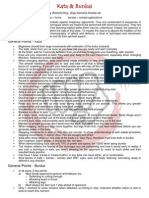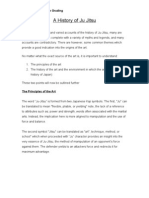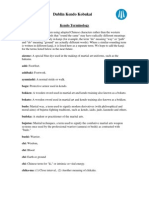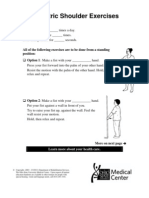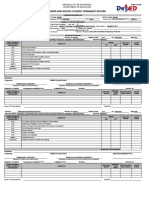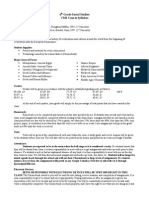Beginning - Karate-Commands and Stances
Uploaded by
Dennis SkrywerBeginning - Karate-Commands and Stances
Uploaded by
Dennis SkrywerBEGINNING KARATE
As with any new endeavor, Karate for the beginner may seem very confusing. These
sheets contain a basic introduction to Karate-Do (the way of Karate) proper etiquette,
philosophy and terminology.
Karate-Do is more than a sport - it is a martial art for the development of character and
physical ability through training. An empty handed art of self-defense with ancient roots
in many Asian countries, karate has been developed and refined into several styles.
Japan Karate Association of Albany, Inc. teaches Shotokan, the most popular Japanese
style karate, which was developed by Gichin Funakoshi. More than ten million people
around the world practice it. This club is a member of the Japan Karate Association
World Federation and the Shotokan Karate-Do America Inc.
Japanese etiquette is followed in the dojo (training area). The basic rules are as follows:
1. Bow as you enter or leave the dojo (this is an expression of courtesy and
respect).
2. Bow to the Sensei (teacher) as he enters the dojo. Your teacher is addressed as
Sensei during class. Black Belt instructors or assistants to the instructor are
addressed as Sempai (Senior).
3. Follow the formal opening and closing ceremony explained hereafter.
4. Class generally begins with the command “line up”. Students line up in front of
and facing the Sensei, more advanced students to his right. Position in line is
determined by the individuals rank and date achieving that rank, i.e. a first
degree black belt of two years standing is more senior than a newly passed first
degree black belt.
5. No talking during an instruction period or practice. If you understand an
instruction or command reply with the Japanese word “Hai”. (Yes-ok). If you have
a question, or do not understand raise your hand.
6. During class stand only in heisoku-dachi (informal attention stance) feet together,
arms relaxed, the hands lightly touching the thighs and eyes focused straight
ahead, or Hachiji-dachi (ready stance) - feet apart, shoulder width - hands in fists
in front of hips and eyes focused straight ahead until you are told relax or shake it
out. Movements, such as yawning, scratching or looking around are not
permitted. Lounging and leaning against walls are also not permitted.
7. Do not leave the dojo during class without requesting permission to do so.
8. After completing the introductory beginners classes all students must wear a gi
(traditional white uniform). Training is in bare feet. When adjusting the gi a
student must face the rear of the dojo.
Japan Karate Association of Albany © 2003 Page 1 of 8
9. All students must follow the basic rules of hygiene. Bathe regularly, cut
fingernails and toenails and wash your practice clothing at least once or twice a
week. Belts are not normally washed, as they will shrink.
10. No jewelry or other ornamentation may be worn during class. No patches or
emblems are allowed on the gi. Headbands are not allowed unless needed. If
needed, they should be white only. Protective pads may not be worn except to
protect an injury.
11. Always be on time for class. It is suggested that a student arrive fifteen (15)
minutes before start of class. If a student comes late because of some
unavoidable circumstance he must saiza (kneel) at the rear of the practice floor
until the instructor gives permission to join the class. Time is needed to wash the
dojo floor before training begins, and if you miss the warm-up, you may well pull
a muscle or injure yourself later in practice.
12. Smoking and food are not allowed in the dojo. Towels, articles of clothing, shoes,
etc. are not allowed on the dojo floor.
NEW STUDENTS
A person starts out in Karate by taking special beginner instruction for a period of about
a month. During this time loose clothing such as sweat pants or shorts and tee shirt are
suggested attire. After learning the basic stances, blocks, punches, and kicks, the
student joins the regular class. At this time, the student must wear a gi with a white belt.
Kyu testing is normally every three months (March, June, September, and December)
and is the method whereby a student advances in rank. Dan testing is twice a year.
FORMAL OPENING AND CLOSING CEREMONY
On the command, “line up”, students form a line, highest in rank to the left, lowest in rank
to the right. Sensei faces the front of the Dojo, his back to the class. The highest ranking
student gives the command, “saiza’ (formal sitting position) and all kneel and sit back on
their heels with backs straight, knees apart approximately the distance of two fists
touching those of the students on either side, hands with fingers closed resting on their
thighs and eyes straight ahead. With the command “mokuso” (clear your mind), all close
their eyes and meditate for a few moments to empty their mind of the days activities and
prepare it for learning. When the word “yame” (stop) is spoken all open their eyes. On
the next Command “shomen ni rei” (to the front bow) all bow in unison. Sensei will turn
and face the class. Then the senior student will say “Sensei ni rei”, at which time Sensei
and students bow to each other, stand, and class begins.
At the end of class “line up”, “saiza”, “mokuso” and “yame” are commanded as in the
beginning. The senior student recites the Dojo Kun (principles we strive for) and all
students repeat each line after him.
Japan Karate Association of Albany © 2003 Page 2 of 8
Dojo Run
Seek perfection of character
Be faithful
Endeavor
Respect others
Refrain from violent behavior
The senior student says, “shomen ni i” and “Sensei ni rei” as in the beginning. All
students then say “thank you Sensei” at which time the Sensei will then rise and leave
the practice area. At this point, class is officially over and students stand and leave the
dojo floor in order of rank.
RANKING
RYU (CLASS) RANKS DAN (Black Belt Degrees)
8TH White Belt 1ST Shodan
7TH 2ND Nidan
3RD Sandan
6TH Green Belt 4TH Yodan
5TH 5TH Godan
4TH 6TH Rokudan
7TH Shichidan
3RD Brown Belt 8TH Hachidan
2ND 9TH Kudan
1ST
Japan Karate Association of Albany © 2003 Page 3 of 8
GLOSSARY
AGE ZUKI: Rising Punch
AGE UKE: Rising block
AWASE ZUKI: U - punch
CHOKU ZUKI: Straight punch
CHUDAN: Chest area
DOJO: Training hail
EMPI: Elbow
EMPI UCHI: Elbow Strike
FUDO DACHI: Rooted stance
FU1IIKOMI: Stamping kick
GEDAN: Lower area of body
GEDAN BARAI: Downward block
GI: Uniform worn during practice
GYAKU ZUKI: Reverse (counter) punch
HACHIJl DACHI: Open-leg stance
HAISHU: Back-hand
HAISHU UCHI: Back-hand strike
HAISHU UKE: Back-hand block
HAISOKU: Instep
HAITO: Ridge-hand
HAITO UCHI: Ridge-hand strike
HAJIME: Command to begin
HANGETSU DACHI: Half-moon stance
HANMI: Half-front facing posture
Japan Karate Association of Albany © 2003 Page 4 of 8
HEIKO DACHI: Parallel stance
HEIKO ZUKI: Parallel punch
HEISOKU DACHI: Informal attention stance
HIDARI: Left
HIRAKEN: Fore-knuckle fist
HIRAKEN ZUKI: Fore-knuckle fist straight punch
HITTSUI: Knee
IPPON: One point
IPPON KEN: One-knuckle fist
IPPON KEN ZUKI: One-knuckle fist straight punch
JYU KUMITE: Free-style sparring
JODAN: Face area
JUJI UKE: X-block
KAGI ZUKI: Hook punch
KAKATO: Heel
KAKE UKE: Hooking block
KAKIWAKE UKE: Wedge block
KAKUTO: Bent wrist
KAKUTO UKE: Bent wrist block
KANKU: “Viewing the sky”
KARATE: Empty-hand fighting
KATA: Forms, or formal exercise
KEAGE: Snap kick
KEITO: Chicken-head wrist
KEITO UKE: Chicken-head wrist block
Japan Karate Association of Albany © 2003 Page 5 of 8
KEKOMI: Thrust Kick
KERI: Kicking
KIBA DACHI: Straddle-leg stance
KIHON KUMITE: Basic sparring
KOKUTSU DACHI: Back stance
KOSHI: Ball of foot
KUMADE: Bear-hand
KUMITE: Sparring
MA-Al: Distancing
MAE GERI: Front kick
MAE GERI KEAGE: Front snap kick
MAE GERI KEKOMI: Front thrust kick
MAE TOBI GERI: Jumping front kick
MAKIWARA: Punching board
‘‘MATE!” ‘‘Wait!’’
MAWASHI GERI: Roundhouse kick
MAWASHI ZUKI: Roundhouse punch
MIGI: Right
MIKAZUKI GERI: Crescent kick
MOROTE UKE: Augmented forearm block
MOROTE ZUKI: Double-fist punch
MUSUBI DACHI: Informal attention Stance, feet turned out
NAGASHI UKE: Sweeping block
NEKO ASH DACHI: Cat stance
NIDAN GERI: Double kick
NIHON NUKITE: Two-finger spear hand
Japan Karate Association of Albany © 2003 Page 6 of 8
NUKITE: Spear hand
Of ZUKI: Lunge punch
SANCHIN DACHI: Hourglass stance
SEIKEN: Fore-fist
SEIKEN CHOKU ZUKI: Punch
SEIRYUTO: Ox-jaw hand
SEIRYUTO UKE: Ox-jaw hand block
SENSEI: Teacher
SHIAI: Contest
SHIKO DACHI: Square stance
SHIZEN TAI: Natural stance
SHUTO: Knife-hand
SHUTO UCHI: Knife-hand strike Fore-fist straight
SHUTO UKE: knife-hand block
SOCHIN DACHI: Diagonal Straddle- leg stance
SOKUTO: Edge of foot
SUKI: Opening
SUKUI LiKE: Scooping block
TANDEtI: Lower Stomach
TATE SHUTO: Vertical knife- hand
TATE SHUTO UKE: Vertical knife-hand block
TATE ZUKI: Vertical fist punch
TEIJI DACHI: I-stance
TEISHO: Palm-heel
TEISHO UCHI: Palm-heel strike
Japan Karate Association of Albany © 2003 Page 7 of 8
TEISHO UKE: Palm-heel block
TOBI KERI: Jump kick
TSUKAMI UKE: Grasping block
TSUKI: Punching
TSUKI LiKE: Punching block
UCHI: Striking
UCHI WAZA: Striking
UDE: Forearm
UDE UKE: Forearm block
URAKEN: Back-fist techniques
URAKEN UCHI: Back-fist strike
USHIRO: Back
USHIRO GERI: Back Kick
WAZA-ARI: Half point
YAMA ZUKI: Wide U-punch
YOKO: Side
YOKO GERI: Side kick
YOKO GERI KEAGE: Side snap kick
YOKO GERI KEKOMI: Side thrust kick
YOKO TOBI GERI:
ZENKUTSU DACHI: Forward stance
Japan Karate Association of Albany © 2003 Page 8 of 8
You might also like
- Self-Learning Module For Grade 11: Chapter Iv: Estimation of ParametersNo ratings yetSelf-Learning Module For Grade 11: Chapter Iv: Estimation of Parameters88 pages
- Aikido - Principles of Kata and RandoriNo ratings yetAikido - Principles of Kata and Randori23 pages
- Old Style Karate, Top 12 Ways It Differs From Modern KarateNo ratings yetOld Style Karate, Top 12 Ways It Differs From Modern Karate3 pages
- Basic Defensive Techniques: Lorca, Vanessa M. BEED-21M1100% (1)Basic Defensive Techniques: Lorca, Vanessa M. BEED-21M122 pages
- 3 RD Dan Grading - History of Ju Jitsu, Philosophy After Black Belt100% (1)3 RD Dan Grading - History of Ju Jitsu, Philosophy After Black Belt16 pages
- 10 Training Sins of Hubad James Keating PDFNo ratings yet10 Training Sins of Hubad James Keating PDF3 pages
- Grade 7: Blue & White Arm-Band 1 8 - 2 1 MonthsNo ratings yetGrade 7: Blue & White Arm-Band 1 8 - 2 1 Months2 pages
- A Personal Safety & Self Defense Presentation: Presented by The UAA PoliceNo ratings yetA Personal Safety & Self Defense Presentation: Presented by The UAA Police38 pages
- Bujinkan Kocho Dojo - Ninja and Samurai Martial ArtsNo ratings yetBujinkan Kocho Dojo - Ninja and Samurai Martial Arts2 pages
- Journal of The College of Chinese Martial Arts 1100% (2)Journal of The College of Chinese Martial Arts 120 pages
- Kenpo Karate Systems - Programa: White BeltNo ratings yetKenpo Karate Systems - Programa: White Belt1 page
- Dalton et al_2016_Multifaceted Contributions by Different Regions of the Orbitofrontal and MedialNo ratings yetDalton et al_2016_Multifaceted Contributions by Different Regions of the Orbitofrontal and Medial11 pages
- Signals and Systems 2nd Edition Textbook SolutionsNo ratings yetSignals and Systems 2nd Edition Textbook Solutions18 pages
- 04 The National Tourism Development Strategy and Programs PDFNo ratings yet04 The National Tourism Development Strategy and Programs PDF26 pages
- NWU - ACA - 010 Syllabus Pagpapahalagang Pampanitikan100% (1)NWU - ACA - 010 Syllabus Pagpapahalagang Pampanitikan11 pages
- Attachment 3 M&E Results - AUTOMATION IN EVALUATING TEST RESULTS USING THE EVALBEE APPLICATIONNo ratings yetAttachment 3 M&E Results - AUTOMATION IN EVALUATING TEST RESULTS USING THE EVALBEE APPLICATION2 pages
- Design Optimization of Bifacial Solar Cell by PC1D Simulation100% (1)Design Optimization of Bifacial Solar Cell by PC1D Simulation11 pages
- RRB ALP Electronics Mechanic 23 Jan 2019 Official Paper Shift 1No ratings yetRRB ALP Electronics Mechanic 23 Jan 2019 Official Paper Shift 150 pages
- National News (Print) : 1st Place - Innocent Anguyo, John Semakula, Fred Turyakira, Godfrey Ojore, Jolly Owiny, Ali Mao and Richard Drasimaku, New VisionNo ratings yetNational News (Print) : 1st Place - Innocent Anguyo, John Semakula, Fred Turyakira, Godfrey Ojore, Jolly Owiny, Ali Mao and Richard Drasimaku, New Vision2 pages
- (Magazine) The Biblical Archaeologist. Vol. 49. No 1No ratings yet(Magazine) The Biblical Archaeologist. Vol. 49. No 170 pages
- Pengembangan PCK (Pedagogical Content Knowledge) Mahasiswa Calon Guru Biologi Fkip Universitas Muhammadiyah Surakarta Melalui Simulasi PembelajaranNo ratings yetPengembangan PCK (Pedagogical Content Knowledge) Mahasiswa Calon Guru Biologi Fkip Universitas Muhammadiyah Surakarta Melalui Simulasi Pembelajaran15 pages
- Senior High School Student Permanent Record: Republic of The Philippines Department of EducationNo ratings yetSenior High School Student Permanent Record: Republic of The Philippines Department of Education3 pages
- Self-Learning Module For Grade 11: Chapter Iv: Estimation of ParametersSelf-Learning Module For Grade 11: Chapter Iv: Estimation of Parameters
- Old Style Karate, Top 12 Ways It Differs From Modern KarateOld Style Karate, Top 12 Ways It Differs From Modern Karate
- Basic Defensive Techniques: Lorca, Vanessa M. BEED-21M1Basic Defensive Techniques: Lorca, Vanessa M. BEED-21M1
- 3 RD Dan Grading - History of Ju Jitsu, Philosophy After Black Belt3 RD Dan Grading - History of Ju Jitsu, Philosophy After Black Belt
- A Personal Safety & Self Defense Presentation: Presented by The UAA PoliceA Personal Safety & Self Defense Presentation: Presented by The UAA Police
- Bujinkan Kocho Dojo - Ninja and Samurai Martial ArtsBujinkan Kocho Dojo - Ninja and Samurai Martial Arts
- The Global Shorinkenjitsu Academy Guide Book.From EverandThe Global Shorinkenjitsu Academy Guide Book.
- Dalton et al_2016_Multifaceted Contributions by Different Regions of the Orbitofrontal and MedialDalton et al_2016_Multifaceted Contributions by Different Regions of the Orbitofrontal and Medial
- Signals and Systems 2nd Edition Textbook SolutionsSignals and Systems 2nd Edition Textbook Solutions
- 04 The National Tourism Development Strategy and Programs PDF04 The National Tourism Development Strategy and Programs PDF
- NWU - ACA - 010 Syllabus Pagpapahalagang PampanitikanNWU - ACA - 010 Syllabus Pagpapahalagang Pampanitikan
- Attachment 3 M&E Results - AUTOMATION IN EVALUATING TEST RESULTS USING THE EVALBEE APPLICATIONAttachment 3 M&E Results - AUTOMATION IN EVALUATING TEST RESULTS USING THE EVALBEE APPLICATION
- Design Optimization of Bifacial Solar Cell by PC1D SimulationDesign Optimization of Bifacial Solar Cell by PC1D Simulation
- RRB ALP Electronics Mechanic 23 Jan 2019 Official Paper Shift 1RRB ALP Electronics Mechanic 23 Jan 2019 Official Paper Shift 1
- National News (Print) : 1st Place - Innocent Anguyo, John Semakula, Fred Turyakira, Godfrey Ojore, Jolly Owiny, Ali Mao and Richard Drasimaku, New VisionNational News (Print) : 1st Place - Innocent Anguyo, John Semakula, Fred Turyakira, Godfrey Ojore, Jolly Owiny, Ali Mao and Richard Drasimaku, New Vision
- (Magazine) The Biblical Archaeologist. Vol. 49. No 1(Magazine) The Biblical Archaeologist. Vol. 49. No 1
- Pengembangan PCK (Pedagogical Content Knowledge) Mahasiswa Calon Guru Biologi Fkip Universitas Muhammadiyah Surakarta Melalui Simulasi PembelajaranPengembangan PCK (Pedagogical Content Knowledge) Mahasiswa Calon Guru Biologi Fkip Universitas Muhammadiyah Surakarta Melalui Simulasi Pembelajaran
- Senior High School Student Permanent Record: Republic of The Philippines Department of EducationSenior High School Student Permanent Record: Republic of The Philippines Department of Education

